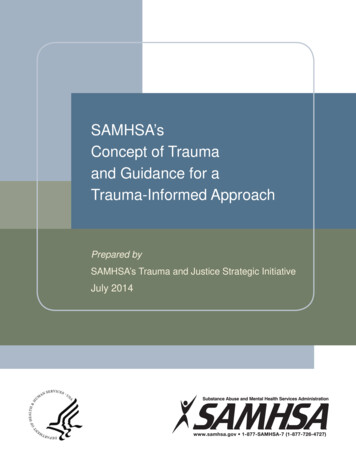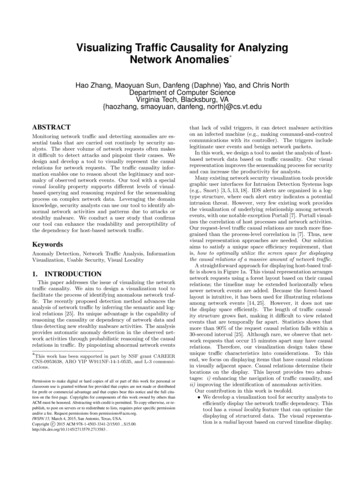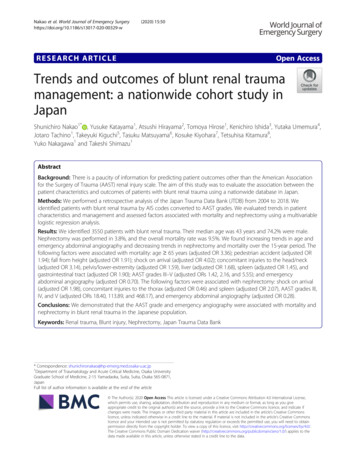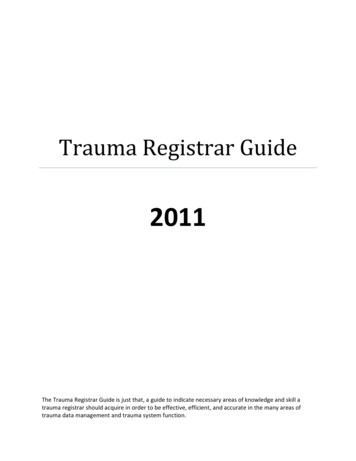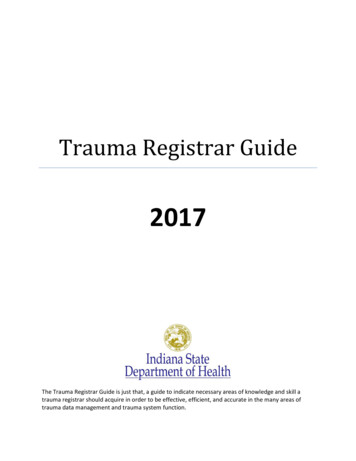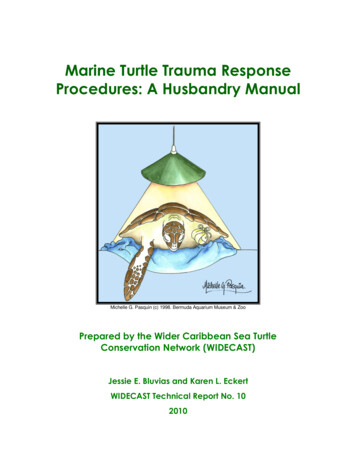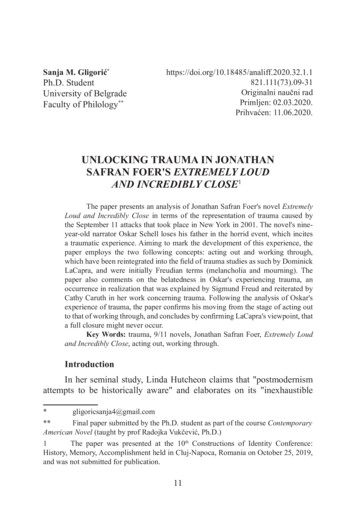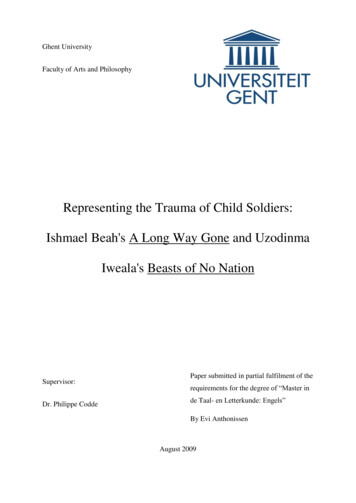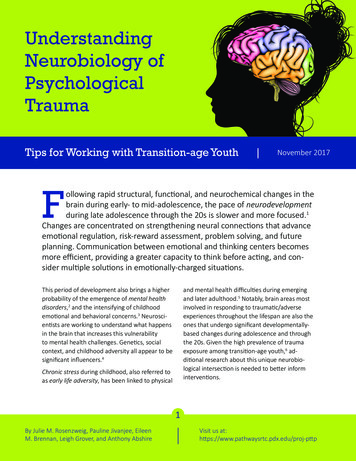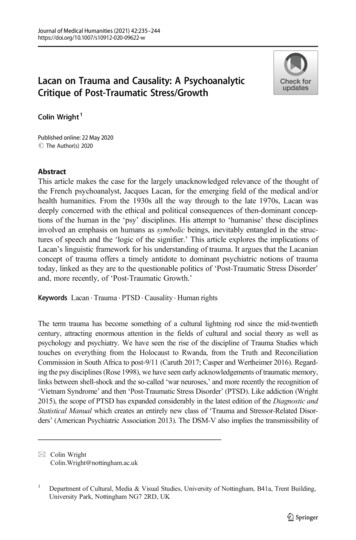
Transcription
Journal of Medical Humanities (2021) 22-wLacan on Trauma and Causality: A PsychoanalyticCritique of Post-Traumatic Stress/GrowthColin Wright 1Published online: 22 May 2020# The Author(s) 2020AbstractThis article makes the case for the largely unacknowledged relevance of the thought ofthe French psychoanalyst, Jacques Lacan, for the emerging field of the medical and/orhealth humanities. From the 1930s all the way through to the late 1970s, Lacan wasdeeply concerned with the ethical and political consequences of then-dominant conceptions of the human in the ‘psy’ disciplines. His attempt to ‘humanise’ these disciplinesinvolved an emphasis on humans as symbolic beings, inevitably entangled in the structures of speech and the ‘logic of the signifier.’ This article explores the implications ofLacan’s linguistic framework for his understanding of trauma. It argues that the Lacanianconcept of trauma offers a timely antidote to dominant psychiatric notions of traumatoday, linked as they are to the questionable politics of ‘Post-Traumatic Stress Disorder’and, more recently, of ‘Post-Traumatic Growth.’Keywords Lacan . Trauma . PTSD . Causality . Human rightsThe term trauma has become something of a cultural lightning rod since the mid-twentiethcentury, attracting enormous attention in the fields of cultural and social theory as well aspsychology and psychiatry. We have seen the rise of the discipline of Trauma Studies whichtouches on everything from the Holocaust to Rwanda, from the Truth and ReconciliationCommission in South Africa to post-9/11 (Caruth 2017; Casper and Wertheimer 2016). Regarding the psy disciplines (Rose 1998), we have seen early acknowledgements of traumatic memory,links between shell-shock and the so-called ‘war neuroses,’ and more recently the recognition of‘Vietnam Syndrome’ and then ‘Post-Traumatic Stress Disorder’ (PTSD). Like addiction (Wright2015), the scope of PTSD has expanded considerably in the latest edition of the Diagnostic andStatistical Manual which creates an entirely new class of ‘Trauma and Stressor-Related Disorders’ (American Psychiatric Association 2013). The DSM-V also implies the transmissibility of* Colin WrightColin.Wright@nottingham.ac.uk1Department of Cultural, Media & Visual Studies, University of Nottingham, B41a, Trent Building,University Park, Nottingham NG7 2RD, UK
236Journal of Medical Humanities (2021) 42:235–244trauma beyond direct personal experience of it: one can now be traumatised by witnessing or evenhearing of the traumas suffered by others.1 This has led to ‘pilots’ of remote drones beingdiagnosed with PTSD, despite being physically far from the front line in the new conditions ofpostmodern warfare. Linked to this contagion effect perhaps, there are now innumerable onlinescreening tools and even apps enabling anyone to self-diagnose PTSD.2 Given the US militarybudget set aside for compensating affected soldiers, as well as equivalents in the private healthinsurance sector, there is a certain ‘market’ in trauma. Without at all denying that there is realhuman suffering behind what the term tries to capture—on the contrary, in fact—I want todescribe this contemporary proliferation as ‘trauma talk.’Trauma talk involves invoking the charged signifier ‘trauma’ in ways that have concreteconsequences in the world precisely thanks to the absence of a consistent referent. Such traumatalk circulates fairly easily, not because of its conceptual rigour or correspondence to an empiricalreality necessarily but because it catalyses sets of values and practices that I want to argue performoperations of individuation relevant to broader neoliberal agendas. Trauma is linked, after all, tothe figure of the victim, to the victim’s rights in a compensation culture, and ultimately to thegeopolitics of human rights. Within the positive psychology movement led by Martin Seligman,PTSD has also been inverted into Post Traumatic Growth (Seligman 2011), arguably a psychological equivalent of the neoliberal principle that ‘every crisis is an opportunity’ in disguise(Mirowski 2013). Nonetheless, it remains talk in a technical sense: one must learn the language oftrauma, whether through the DSM’s vocabulary of ‘intrusion,’ ‘avoidance’ and ‘hyper-arousal’ orthrough an engagement with self-help literature with its language of ‘survivors’ and ‘recovery.’ Inthe field of critical social theory, there has been an ethical discourse around the notion of traumaever since Adorno declared the impossibility of poetry after Auschwitz (1990). By contrast, intoday’s more diffuse and medicalised ‘trauma talk,’ there is a loquaciousness that deserves to becharacterised as a ‘discourse’ in Michel Foucault’s specific sense (1980). The discourse of traumatalk in fact abhors silence, insisting that trauma must be verbalised.For better or for worse, behind the success of ‘trauma talk’ is undoubtedly a certain readingof Freud. For Trauma Studies as a cultural and social theory, Freud is still credited withrecognising the link between trauma and repressed or screen memories and also with trauma’sresistance to psychic representation at the individual and social level (Fletcher 2013; Eekhoff2019). Even the psychiatric framing of PTSD retains a clear indebtedness to Freudian ideasabout repression and repetition compulsion. But as a psychoanalyst, I have learned to alwaysask which Freud? There are many after all. Which one does ‘trauma talk’ invoke? Speakingvery generally, it seems to be the Freud of the very early Seduction Theory which can be datedback to a paper delivered in April 1896, entitled ‘The Aetiology of Hysteria’ (though twoprevious publications, ‘Heredity and the Aetiology of the Neuroses’ [1962a] and ‘FurtherRemarks on the Psych-Neuroses of Defence’ [1962b], had already sketched the argument).What Freud outlined in these so-called Seduction papers is indeed a post-traumatic model ofneurosis, but one which, crucially, is not psychoanalytic.Freud’s Seduction Theory arose from his early clinical work with hysterics in collaborationwith Josef Breuer (Freud and Breuer 1991). Because free association seemed to reverse therepression of erotically charged material, Freud postulated an aetiology for hysteria based on amodel of traumatic memory: these women, he believed, had suffered actual experiences ofsexual abuse, but the resulting memory traces had been repressed from consciousness. Findingno psychic representation in the memory system, this traumatic imposition from the outside, ofa sexuality for which these subjects were not developmentally ready, was both repressed andexpressed in their conversion symptoms, as if their bodies spoke of what their minds could not
Journal of Medical Humanities (2021) 42:235–244237confront. The classic example among Freud’s case studies is ‘Emma,’ a young woman whopresented with a phobia of entering shops. During analysis, she was able to access a repressedmemory from her eighth year when she was molested by a shopkeeper. Most of the elementsof trauma as now popularly conceived are already present in this Freudian example:1)2)3)4)a terrible shock ‘hits’ the organism from outside;this shock is linked to either the threat of death or imposed sexuality;it cannot be processed through existing frameworks of meaning;yet the repressed returns in repetitive symptomatic forms (for Emma, her phobic panicattacks triggered by shop doorways).As well as establishing these foundational elements, Freud lent impetus to the notion that the veryact of talking about a trauma can potentially cure it. This fits well with today’s therapeutic culturewhich has commodified this aspect of Freud to the point that the company British Telecom couldturn it into a marketing slogan in the 1980s—‘it’s good to talk.’ But what is forgotten here is thepeculiar specificity of talking in analysis under conditions of transference and free association, veryunlike everyday communication. Clinically speaking, it is certainly not the case that it is always‘good to talk’ too quickly or too directly about a trauma. What is also forgotten is that Freud utterlyrenounced his Seduction Theory and had to, in order go on and invent psychoanalysis proper.In a letter to Wilhelm Fliess dated the 21st of September 1897, Freud explicitly abandonedthe Seduction Theory (1985). It had become apparent to him that the sexual content arisingfrom free association did not always relate to repressed memories of real events. He wasmoving away from the restrictive model of experiential memory in order to better describe anunconscious he increasingly realised observed distinct laws. He therefore came to postulate thatthe sexual nature of these hysterical ‘memories’ related not to real experiences per se butinstead to Oedipal fantasies and to the constitutively libidinal nature of the unconscious itself.For good reasons, this move has been a controversial one (Masson 1992), but only byabandoning the early Seduction Theory could Freud make the truly revolutionary argumentshe developed in his Three Essays on Sexuality (1977). Whereas the pre-psychoanalyticSeduction Theory presented the trauma of sexuality as an external contingency, shocking thepsychic system from without, the libidinal theory of the unconscious made the trauma ofsexuality innate and primordial, giving proper primacy to what Freud called psychic reality.What today’s consumer culture veils, precisely in its commodification of sexuality as a lifestylechoice and a right to endless enjoyment, is the darker but more properly Freudian point:namely, that human sexuality is unavoidably traumatic.Given that the DSM IV classified PTSD as an ‘anxiety disorder,’ it is worth pointing outthat one can observe a similarly partial reading of Freud’s ideas on anxiety in some CognitiveBehavioral Therapy (CBT) frameworks. Rather than recognising the psychic reality of a fearwithout empirical locus, as Freud was careful to do in Inhibitions, Symptoms and Anxiety(1985), such CBT frameworks tend to reduce anxiety to a once realistic fear of empiricaldanger, the attendant signals of which have been misperceived. It was this understanding ofanxiety as an irrational fear of fear that led to the notion of therapeutic ‘immersion’ or‘flooding’ by means of which an experience that would correct the individual’s relation toreality could be induced. Whether in psychiatric conceptualisations of trauma per se or anxiety,one can discern the influence of behaviourism and a fairly naïve stimulus-response model, andvery similar notions are now articulated through the alternative vocabulary of neuroscienceand neuronal ‘plasticity’ (Abi-Rached and Rose 2010).
238Journal of Medical Humanities (2021) 42:235–244In these deviations from Freud, sometimes in the name of another Freud, I would argue thatwhat is really at stake, ethically and eventually politically, is two quite incompatible models ofcausality.Traumatic causalityIn common with Freud’s pre-psychoanalytic Seduction Theory, PTSD conceptualises traumain terms of a fairly linear, Newtonian—or Pavlovian—causality. In the vocabulary of theDSM, there is an initial ‘stressor event’ which then goes on to have pathological consequencessuch as persistent re-experiencing in nightmares, hyper-arousal and extreme avoidance behaviours. A, that is, leads to B. Because of its historical and institutional links to war, there is muchless scope today for the idea that the stressor event could be unconscious. The victim of traumagenerally knows what the traumatic event was, and the almost juridical emphasis is ondemonstrating the causal link between it and subsequent disordered behaviour. There issomething paradoxical, therefore, about ‘trauma talk.’ On the one hand, it foregrounds thehorror of the unexpected, the unpredictable, the out-of-the-blue. Yet on the other, it posits acause-and-effect relation that is determinate enough to make of the traumatised individual ahelpless victim of unfortunate circumstances. The circularity, as it were, of this linearity, canclearly be seen in its reversal: a great deal of research now goes into identifying genetic riskfactors that predispose for PTSD.3 Psychometric as well as physical tests for the militaryattempt to screen for such predispositions, and ‘psychological briefings’ have been used toprevent the onset of PTSD immediately after conflict. This push for early intervention andpreventative medicine fits well both with neoliberal cost-benefit analyses of healthcare provision (Polzer and Power 2016) and with what Ulrick Beck has called ‘risk society’ (2009). Notonly armies but governments now present themselves as capable of eradicating contingencywithin administrative frameworks of predictability.However, staying closer to Freud’s properly psychoanalytic abandonment of the SeductionTheory yields a profoundly different model of causality. Freud himself claimed to be constitutively incapable of doing philosophy. While the proximity of some of his ideas to those ofSchopenhauer and Nietzsche permit us to doubt him on this score, it was nevertheless hisfidelity to his clinical practice, rather than a taste for abstraction, that led him to sketch a nonor anti-Pavlovian theory of psychic causality. The transitional text, Beyond the PleasurePrinciple, of 1920 emerged from clinical work with victims of shell shock after WWI. In it,he both revised the pleasure principle in the face of the repetition compulsion and posited thecontroversial death instinct. But as usual with Freud’s work, one can find the seeds of theselater elaborations even in the earliest writings.Let us take the case-study of ‘Emma’ again. Already, Freud had recognised a recursiverelationship between the two elements that Emma, after analysis, was able to bring in torelation: intuitively, we would place the inappropriate touching she, at the age of eight,experienced at the hands of the shopkeeper as the ‘stressor event’ that then led to
Seduction Theory presented the trauma of sexuality as an external contingency, shocking the psychic system from without, the libidinal theory of the unconscious made the trauma of sexuality innate and primordial, giving proper primacy to what Freud called psychic reality.
